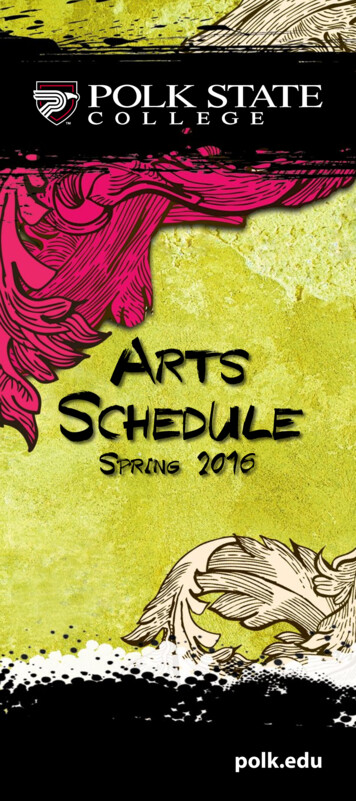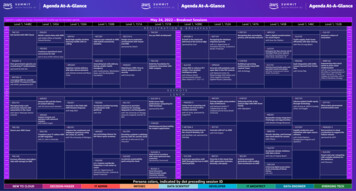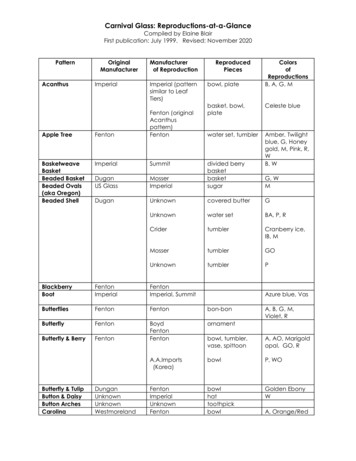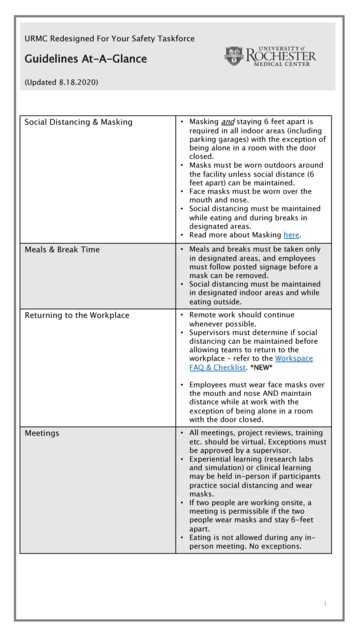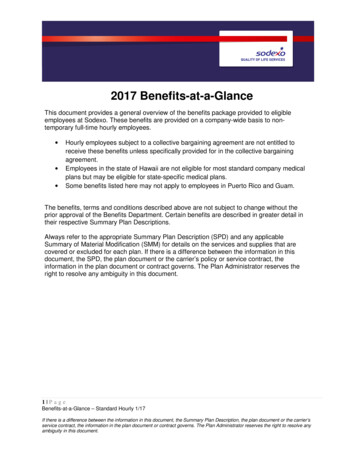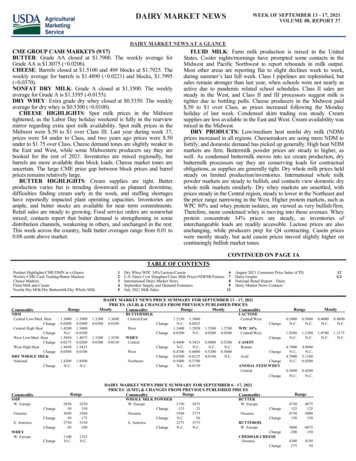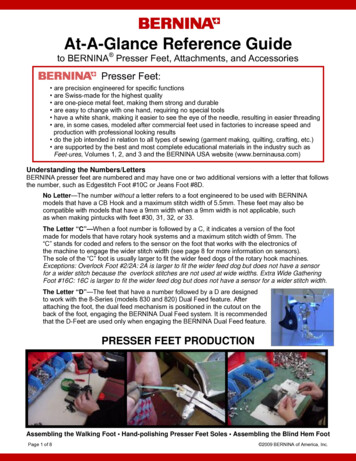
Transcription
S CHEDU LE A T -AT - GL ANCEMonday 2/27/20179:00 a.m. – 7:00 p.m.Conference Registration Desk OpenBanquet Lobby9:00 a.m. – 7:00 p.m.Exhibitor Set-upFrontenac12:00 p.m. – 7:00 p.m.Poster Set-upAmbassadeur Ballroom3:00 p.m. – 5:00 p.m.SEDSG Technical Committee MeetingLe Café6:00 p.m. – 9:00 p.m. Welcome Social!Frontenac7:00 a.m. – 5:00 p.m.Conference Registration Desk OpenBanquet Lobby7:00 a.m. – 5:00 p.m.Exhibitor DisplaysFrontenac7:00 a.m. – 5:00 p.m.Poster DisplaysAmbassadeur Ballroom8:00 a.m. – 9:50 a.m.Technical Session IAmbassadeur Ballroom9:50 a.m. – 10:10 a.m.Refreshment BreakFrontenac10:10 a.m. – 12:10 p.m.Technical Session IIAmbassadeur Ballroom12:10 p.m. – 1:30 p.m.Lunch on your own1:30 p.m. – 3:20 p.m.Technical Session IIIAmbassadeur Ballroom3:20 p.m. – 3:40 p.m.Refreshment BreakFrontenac3:40 p.m. – 5:00 p.m.Technical Session IVAmbassadeur BallroomTuesday 2/28/2017Dinner on your own7:00 p.m. – 9:00 p.m. “Shoot from the Hip” SocialAmbassadeur BallroomWednesday 3/1/20177:00 a.m. – 5:00 p.m.Conference Registration Desk OpenBanquet Lobby7:00 a.m. – 5:00 p.m.Exhibitor DisplaysFrontenac7:00 a.m. – 5:00 p.m.Poster DisplaysAmbassadeur Ballroom8:00 a.m. – 9:50 a.m.Technical Session VAmbassadeur Ballroom9:50 a.m. – 10:10 a.m.Refreshment BreakFrontenac10:10 a.m. – 12:10 p.m.Technical Session VIAmbassadeur Ballroom12:10 p.m. – 1:30 p.m.Lunch on your own1:30 p.m. – 3:20 p.m.Technical Session VIIAmbassadeur Ballroom3:20 p.m. – 3:40 p.m.Refreshment BreakFrontenac3:40 p.m. – 5:00 p.m.Technical Session VIIIAmbassadeur Ballroom5:00 p.m. – 6:30 p.m.SEDSG Technical Committee Business MeetingLe Café6:00 p.m. – 7:00 p.m. Pre-Banquet Networking SocialAtrium (Clayton Building, 2ndFloor)7:00 p.m. – 9:00 p.m. Banquet & AwardsClayton Ballroom (ClaytonBuilding, 1st Floor)
T ECHNI CAL S ESSI ON S CHED UL ETUESDAY FEBRUARY 28, 2017*Student PresenterTECHNICAL SESSION IModerator: Charles W. Anderson, Missouri Department of Conservation8:00 AMIntroductionsCharles W. Anderson – Resource Science Supervisor, Missouri Department of Conservation8:10 AMWelcomeTom A. Draper – Deputy Director, Missouri Department of Conservation8:20 AMJohn F. Organ – Chief, U.S.G.S. Cooperative Fish and Wildlife Research Units8:50 AMJason A. Sumners – Wildlife Division Chief, Missouri Department of Conservation9:20 AMKelly Straka – Wildlife Health Section Supervisor, Michigan Department of Natural Resources9:50 AMBreakTECHNICAL SESSION IIModerator: Kevyn H. Wiskirchen, Missouri Department of Conservation10:10 AMFive (or More) Decades of Chronic Wasting Disease: Lessons for the Next Five DecadesMichael W. Miller, Colorado Parks and Wildlife; John R. Fischer, Southeastern Cooperative WildlifeDisease StudyPresenter: John Fischer10:30 AMNational Deer Alliance and the Political Science of CWDNick Pinizzotto, National Deer Alliance10:50 AMOnce Bitten, Twice Shy: New York’s Risk-based Approach to Chronic Wasting DiseaseKrysten Schuler, Cornell University11:10 AMChronic Wasting Disease in ArkansasCory Gray, Arkansas Game and Fish Commission; Ralph Meeker, Arkansas Game and Fish Commission11:30 AMYou Can’t Bring That Here! Working Together to Reduce the Risk of CWD IntroductionMerril Cook, North Carolina Wildlife Resources Commission; Maria Palamar, North Carolina WildlifeResources Commission11:50 AMA Model-based Framework for Improving Chronic Wasting Disease Surveillance in White-tailed DeerPopulations of MissouriAniruddha Belsare, University of Missouri; Jason Sumners, Missouri Department of Conservation; EmilyFlinn; Barbara Keller, Missouri Department of Conservation; Matthew Gompper, University of Missouri;Joshua Millspaugh, University of Montana12:10 PMLunch on your own
TUESDAY FEBRUARY 28, 2017TECHNICAL SESSION IIIModerator: Ryan E. Leeson, Southern Illinois University-Carbondale1:30 PMAnnouncements1:40 PM*Browsing Optimization Hypothesis: Influence of Deer DensityJustin P. Young, Timothy E. Fulbright, David G. Hewitt, Charles A. DeYoung – Caesar Kleberg WildlifeResearch Institute, Texas A&M University-Kingsville; Don A. Draeger, Comanche Ranch2:00 PMManaging Deer at the Intersection of Ecosystem Restoration, Game Management, and EndangeredSpecies ConservationElina P. Garrison, Florida Fish and Wildlife Conservation Commission; Stephen M. Shea, Florida Fish andWildlife Conservation Commission; Cory R. Morea, Florida Fish and Wildlife Conservation Commission;Michael J. Cherry, Virginia Tech; David B. Shindle, U.S. Fish and Wildlife Service; Richard B. Chandler,University of Georgia; L. Mike Conner, Joseph W. Jones Ecological Research Center; Karl V. Miller,University of Georgia2:20 PMSupplemental Feeding and Baiting Regulations: Do They Make Sense?Tim Neuman, Ani-Logics Outdoors; Brian Dorcey, Veterinary Medical Center2:40 PMState of the Whitetail: Trends in Harvest and Management ProgramsKip Adams, Quality Deer Management Association; Matt Ross, Quality Deer Management Association;Brian Murphy, Quality Deer Management Association3:00 PMNew Time: Influence of Soil Nutrients on Plant Nutrition for White-tailed DeerCraig A. Harper, University of Tennessee; Marcus A. Lashley, Mississippi State University; Jordan S.Nanney, University of Tennessee; Bronson K. Strickland, Mississippi State University3:20 PMBreakTECHNICAL SESSION IVModerator: Jonathan K. Trudeau, Ball State University3:40 PM*20 Years of the Modern Vaginal Implant Transmitter: Then and NowJustin R. Dion, University of Delaware; Jacob L. Bowman, University of Delaware; Jacob M. Haus,University of Delaware; Joseph E. Rogerson, Delaware Department of Natural Resources andEnvironmental Control4:00 PM*Retention of Expandable Collars on Male White-tailed DeerJacob M. Haus, University of Delaware; Jacob L. Bowman, University of Delaware; Joseph E. Rogerson,Delaware Department of Natural Resources and Environmental Control4:20 PM*Estimating White-tailed Deer Fawn Survival and Recruitment with Spatial Capture-recapture Modelsand Camera DataKristin N. Engebretsen, University of Georgia; Michael J. Cherry, Virginia Tech; Elina Garrison, Florida Fishand Wildlife Conservation Commission; Karl V. Miller, University of Georgia; Richard B. Chandler,University of Georgia4:40 PM*Do Preseason Camera Surveys Reflect Harvest Availability During the Hunting Season?James T. Johnson, University of Georgia; Michael J. Cherry, Virginia Tech; L. Mike Conner, Joseph W. JonesEcological Research Center; Richard B. Chandler, University of Georgia; Brandon T. Rutledge, Joseph W.Jones Ecological Research Center; Charlie H. Killmaster, Georgia Department of Natural Resources;Michael T. Biggerstaff, University of Georgia; Karl V. Miller, University of Georgia
WEDNESDAY MARCH 1, 2017TECHNICAL SESSION VModerator: Emily H. Belser, Texas A&M University-Kingsville8:00 AMAnnouncements8:10 AMNew World Screwworm Infestation of Key DeerRebecca Shuman, Florida Fish and Wildlife Conservation Commission; Samantha Gibbs, U.S. Fish andWildlife Service; Mark Cunningham, Florida Fish and Wildlife Conservation Commission; Lara Cusak,Florida Fish and Wildlife Conservation Commission; Cory Morea, Florida Fish and Wildlife ConservationCommission8:30 AM*New World Screwworm Impacts on the Endangered Florida Key DeerJared Beaver, Israel Parker, Brian Pierce – Texas A&M University; Kate Watts, U.S. Fish & Wildlife Service;Nova Silvy, Texas A&M University; Roel Lopez, Texas A&M University8:50 AMIs Drought a Risk Factor for Hemorrhagic Disease in the Eastern United States?David Stallknecht, Southeastern Cooperative Wildlife Disease Study; Mark Ruder, SoutheasternCooperative Wildlife Disease Study; John Fischer, Southeastern Cooperative Wildlife Disease Study; SonjaChristensen, Michigan State University9:10 AMEpizootic Hemorrhagic Disease Virus Serotype 6 in the United States: The First 10 Years (2006-2015)Mark G. Ruder, Southeastern Cooperative Wildlife Disease Study; Donna Johnson, National VeterinaryServices Laboratories; Eileen Ostlund, National Veterinary Services Laboratories; Andrew B. Allison,Virginia Tech; Clara Kienzle, Southeastern Cooperative Wildlife Disease Study; Jamie E. Phillips, AaltoScientific; Rebecca L. Poulson, Southeastern Cooperative Wildlife Disease Study; David E. Stallknecht,Southeastern Cooperative Wildlife Disease Study9:30 AM*Genetic Contribution of Northern Lineages to Free-range Populations of White-tailed Deer inSouthcentral U.SJordan L. Youngmann, Mississippi State University; Steve Demarais, Mississippi State University; Randy W.DeYoung, Texas A&M University-Kingsville; Bronson Strickland, Mississippi State University9:50 AMBreakWEDNESDAY MARCH 1, 2017TECHNICAL SESSION VIModerator: Alicia M. Lombardo, Missouri Department of Conservation10:10 AM*Factors Influencing Nutritional Condition of White-tailed Deer in the Appalachian Mountains ofVirginiaAndrew B. Kniowski, Virginia Tech; Michael J. Cherry, Virginia Tech; Nelson W. Lafon, Virginia Departmentof Game and Inland Fisheries; David E. Steffen, Virginia Department of Game and Inland Fisheries; W.Matt Knox, Virginia Department of Game and Inland Fisheries; W. Mark Ford, U.S. Geological Survey10:30 AMNew Time: A Comparison of Results from USDA and Farm Bureau Survey Efforts Regarding Deer inMissouriRonald Reitz, Missouri Department of Conservation
10:50 AM*Modeling Nutritional Carrying Capacity and Summer Forage Distribution for Deer in the CumberlandMountains, TennesseeJordan Nanney, University of Tennessee; Craig Harper, University of Tennessee; David Buehler, Universityof Tennessee; Gary Bates, University of Tennessee11:10 AMConsistency and Reliability of Deer Ages from Central FloridaDonal A. Woodard, Deseret Ranches; Justin Field, Deseret Ranches11:30 AM*Evaluation of Culling Intensity and Criteria for Antler Traits in White-tailed DeerMasahiro Ohnishi, Texas A&M University-Kingsville; Randy W. DeYoung, Texas A&M University-Kingsville;Charles A. DeYoung, Texas A&M University-Kingsville; Bronson Strickland, Mississippi State University;Steven Lukefahr, Texas A&M University-Kingsville; Don A. Draeger, Comanche Ranch; David G. Hewitt,Texas A&M University-Kingsville11:50 PM*Effects of Resource Density, Deer Age, and Sex on a Concentrated Resource by White-tailed DeerEmily H. Belser, David G. Hewitt, Timothy E. Fulbright, Charles A. DeYoung, David B. Wester – Texas A&MUniversity-Kingsville; Thomas W. Boutton, Texas A&M University; Don A. Draeger, Comanche Ranch12:10 PMLunch on your ownTECHNICAL SESSION VIIModerator: Jordan L. Youngmann, Mississippi State University1:30 PMAnnouncements1:40 PMTitle Correction: *Comparison of Adult Urban and Rural White-tailed Deer Space Use in SouthernIndianaJonathan K. Trudeau, Ball State University; Garrett B. Clevinger, Ball State University; Timothy C. Carter,Ball State University2:00 PM*A Comparison of White-tailed Deer Recruitment Rates to Relative Predator Abundance in MarylandEric Ness, University of Delaware; Jacob L. Bowman, University of Delaware; Brian Eyler, MarylandDepartment of Natural Resources2:20 PM*Survival and Cause-specific Mortality of Adult White-tailed Deer on Public and Private LandsKevyn H. Wiskirchen, Auburn University; Todd C. Jacobsen, Auburn University; Stephen S. Ditchkoff,Auburn University; Steve Demarais, Mississippi State University; James B. Grand, U.S. Geological Survey2:40 PM*Factors Affecting Survival of Neonatal White-tailed Deer in MissouriChloe A. Wright, University of Montana; Jon T. McRoberts, University of Missouri; Joshua J. Millspaugh,University of Montana; Barbara J. Keller, Missouri Department of Conservation3:00 PM*Dead Downwind: Quantifying Caution in White-tailed DeerDaniel Crawford, University of Georgia; Michael J. Cherry, Virginia Tech; Brian Kelly, University of Georgia;Richard B. Chandler, University of Georgia; Elina Garrison, Florida Fish and Wildlife ConservationCommission; L. Mike Conner, Joseph Jones Ecological Research Center; Karl V. Miller, University ofGeorgia3:20 PMBreak
TECHNICAL SESSION VIIIModerator: Jacob M. Haus, University of Delaware3:40 PMCommunity Deer Management in Town & Country, Missouri: Sharpshooting and Sterilization to ReduceDeer DensityErin Shank, Missouri Department of Conservation4:00 PMA Changing Landscape in the Northern Georgia Mountains: Bear, Deer, and ForestsAndrew R. Little, University of Georgia; Gino J. D'Angelo, University of Georgia; Charlie H. Killmaster,Georgia Department of Natural Resources; Kristina L. Johannsen, Georgia Department of NaturalResources; Karl V. Miller, University of Georgia4:20 PMFrom Ridiculed to Recognized: 22 Years of Deer Research and Management on Hilton Head, SCDavid Henderson, Community Services Associates; Robert Warren, University of Georgia; Charles Ruth,South Carolina Department of Natural Resources4:40 PMOrganized Archery Hunting to Manage White-tailed Deer Populations in Fairfax County, VirginiaKevin R. Rose, Virginia Department of Game and Inland Fisheries; Katherine Edwards, Fairfax CountyPolice Department
P OST ER S ESS IONTUESDAY & WEDNESDAY 7:00 AM – 5:00 PMPosters are listed in alphabetical order by last name of the primary author, and each has been assigneda poster number. Poster authors will be available to discuss their posters during the scheduled breaks.*Student PresenterP-01 *To Bait or Not to Bait: Comparing Camera Survey Methods for White-tailed Deer Population EstimationRobert Baldwin, Wake Forest University; Jared Beaver; Michael Anderson; Matt Windsor; Miles SilmanP-02 *Using Passive Cameras to Monitor Deer Activity Patterns During the Breeding SeasonMichael T. Biggerstaff, University of Georgia; Michael J. Cherry, Virginia Tech University; L. Mike Conner, Joseph W. JonesEcological Research Center; Richard B. Chandler, University of Georgia; Charlie Killmaster, Georgia Department of NaturalResources; James T. Johnson, University of Georgia; Karl V. Miller, University of GeorgiaP-03 *Varying Perceptions of Coyotes Within the Hunting CommunityC. Moriah Boggess, North Carolina State University; Mark A. Turner, North Carolina State University; Michael D. Drake,North Carolina State University; Mallory Gyovai, North Carolina State University; M. Nils Petersen, North Carolina StateUniversity; Chris Serenari, North Carolina Wildlife Resources Commission; Colleen Olfenbuttel, North Carolina WildlifeResources CommissionP-04 *Can Vegetation Characteristics Indicate Habitat Quality for White-tailed Deer (Odocoileus virginianus)?Donald P. Chance, Mississippi State University; Johannah R. McCollum, Mississippi State University; Marcus A. Lashley,Mississippi State University; Garrett M. Street, Mississippi State University; Bronson Strickland, Mississippi State UniversityP-05 * Comparison of Seasonal Movements Between Localized Populations of Urban and Rural White-tailed Deer inSouthern IndianaGarrett B. Clevinger, Ball State University; Jonathan K. Trudeau, Ball State University; Timothy C. Carter, Ball State UniversityP-06 *Understanding Mechanisms of Diet Selection in White-tailed DeerJacob Dykes, Mississippi State University; Marcus Lashley, Mississippi State University; Bronson Strickland, Mississippi StateUniversity; Steve Demarais, Mississippi State University; Dan Reynolds, Mississippi State UniversityP-07 Evaluation of Insecticides and Repellents for Suppression of Feeding Injury by Deer in SoybeansW. Cory Heaton, Clemson University; Jeremy K. Greene, Clemson University; David Gunter, Clemson University; JonathanCroft, Clemson Cooperative Extension ServiceP-08 *Proactive Anti-predator Behavior of White-tailed Deer (Odocoileus virginianus) During Fawning SeasonSummer D. Higdon, University of Missouri-Columbia; Corinne A. Diggins, Virginia Tech; Michael J. Cherry, Virginia Tech; W.Mark Ford, Virginia Cooperative Fish and Wildlife UnitP-09 *Does Social Class of White-tailed Deer Influence Use of Supplemental Feeders?Onalise R. Hill, Texas A&M University–Kingsville; Justin P. Young, Texas A&M University–Kingsville; Timothy E. Fulbright,Texas A&M University–Kingsville; David G. Hewitt, Texas A&M University–Kingsville; Charles A. DeYoung, Texas A&MUniversity–Kingsville; Don A. Draeger, Comanche RanchP-10 *Influence of White-tailed Deer on Oak and Hickory Regeneration in Southern IllinoisRyan E. Leeson, Southern Illinois University Carbondale; Clayton K. Nielsen, Southern Illinois University Carbondale; DevonC. Oliver, Southern Illinois University Carbondale; Eric J. Holzmueller, Southern Illinois University Carbondale
P OST ER S ESS ION co nt inu edP-11 *Comparison of Food Plot Mixtures for Attracting White-tailed DeerRyan E. Leeson, Southern Illinois University Carbondale; Clayton K. Nielsen, Southern Illinois University Carbondale; DevonC. Oliver, Southern Illinois University Carbondale; William J. Banz, Southern Illinois University CarbondaleP-12 *Female Mate Choice in White-tailed Deer: Does Male Phenotypic Quality Inform Preference?Daniel L. Morina, Mississippi State University; Steve Demarais, Mississippi State University; Bronson K. Strickland,Mississippi State University; Jamie E. Larson, Mississippi State UniversityP-13 *Does White-tailed Deer Browsing Result in Browse Lines on Three Preferred South Texas Woody Plants?Lindsey M. Phillips, Texas A&M University–Kingsville; Timothy E. Fulbright, Texas A&M University–Kingsville; David G.Hewitt, Texas A&M University–Kingsville; Charles A. DeYoung, Texas A&M University–Kingsville; Don A. Draeger, ComancheRanchP-14 The Culicoides Enigma: Which Biting Midge Species Are Important in HD Epidemiology in the Southeast?Mark G. Ruder, Southeastern Cooperative Wildlife Disease Study; Stacey L. Vigil, Southeastern Cooperative Wildlife DiseaseStudy; David E. Stallknecht, Southeastern Cooperative Wildlife Disease Study; David Shaw, Southeastern CooperativeWildlife Disease Study; Matthew D. Walter, Southeastern Cooperative Wildlife Disease Study; Clara Kienzle, SoutheasternCooperative Wildlife Disease Study; Kayla Garrett, Southeastern Cooperative Wildlife Disease Study; Joseph L. Corn,Southeastern Cooperative Wildlife Disease StudyP-15 *Quantifying the Effects of Coyotes on Vigilance Behavior in White-tailed DeerD.S. Steakley, Mississippi State Univerisity; M.A. Lashley, Mississippi State University; M.C. Chitwood, University ofMontana; C.S. DePerno, North Carolina State University; C.E. Moorman, North Carolina State UniversityP-16 *Spatio-temporal Responses of White-tailed Deer to the Use of Bait During the Hunting SeasonDavid B. Stone, University of Georgia; Tom Prebyl, University of Georgia; James A. Martin, University of Georgia; CharlieKillmaster, Georgia Department of Natural Resources; Karl V. Miller, University of GeorgiaP-17 *Breeding Chronology and Social Interactions Affect White-tailed Deer Vigilance at Bait SitesDavid B. Stone, University of Georgia; Michael J. Cherry, Virginia Tech; Bradley S. Cohen, University of Georgia; James A.Martin, University of Georgia, Charlie Killmaster, Georgia Department of Natural Resources; Karl V. Miller, University ofGeorgiaP-18 *Temporal Resolution of the White-tailed Deer Visual System and Implications for Movement DetectionEryn M. Watson, University of Georgia; Bradley S. Cohen, University of Georgia; David A. Osborn, University of Georgia;Michele Barletta, University of Georgia; Kate Myrna, University of Georgia; Krista Mitchell, University of Georgia; Karl V.Miller, University of Georgia
A BST R ACTSTUESDAY. 2/28/2017. TECHNICAL SESSION IITuesday, 10:10 AMFive (or More) Decades of Chronic Wasting Disease: Lessons for the Next Five DecadesAuthorsMichael W. Miller, Colorado Parks and Wildlife; John R. Fischer, Southeastern Cooperative WildlifeDisease StudyPresenter: John FischerAbstractChronic wasting disease (CWD) has run the gamut from minor scientific curiosity to national crisis sinceit first was recognized in the late 1960s. As of November 2016, CWD had been reported in captiveand/or wild cervids in 24 states, three provinces, South Korea, and Norway. With few exceptions, oncein the wild CWD has persisted in the face of varied control attempts. Several factors have contributedto CWD’s spread and persistence: Natural factors include prolonged incubation, multiple routes ofagent shedding, the agent’s environmental persistence, and natural movements of wild cervids.Anthropogenic factors include movement of infected live animals (and perhaps infectious tissues andother materials), concentrating susceptible species, and other artificial management practices. Manyfacets of CWD biology and ecology now are understood, but science informing effective managementand control strategies remains incomplete. Eradicating CWD appears infeasible given its distributionand other epidemiological attributes. Regardless, adaptive approaches for containing foci and reducingprevalence have shown some promise and deserve further attention. Such pursuits undoubtedly willbe more difficult to garner support for in sociopolitical climates ranging from apathetic to combative;however, we believe there are two important motivations for making progress toward sustainablecontainment and control strategies for CWD in the coming decades: Data from several sources suggestthat heavily-infected cervid populations will not thrive in the long-term. Second, data on CWD prionsand experience with other animal prion diseases suggest minimizing human exposure to these agentsis prudent.Key Words: chronic wasting diseaseContact: jfischer@uga.eduNOTES:
Tuesday, 10:30 AMNational Deer Alliance and the Political Science of CWDAuthorsNick Pinizzotto, National Deer AllianceAbstractThe mission of the National Deer Alliance (NDA) is to serve as the guardian of wild deer conservationand our hunting heritage. Despite 83% of the nearly 14 million hunters in the United States identifyingthemselves as deer hunters, there was no national organization geared toward protecting the interestsof all deer, hunters and the deer hunting industry before the formation of NDA. NDA serves as a policyfocused umbrella group to its founding organizations, QDMA, Mule Deer Foundation, and WhitetailsUnlimited.NDA's key priorities include wild deer conservation, diseases, hunter access, predators andcompetitors, and state and federal land management. Deer diseases are the current top priority of theorganization, particularly chronic wasting disease (CWD). NDA recently formed a special working groupmade up of national conservation groups and other thought leaders to submit comments to USDA fortheir CWD Program Standards for management of captive cervids. In addition, the organization isworking on a critical strategy for ensuring that the threat of CWD is better understood on Capitol Hill,as well as in the state legislators.While the threat of CWD to wild deer is real, we face a number of challenges when it comes to creatinga sense of urgency among sportsmen, legislators, and other decision makers. In addition, someindividuals prominent in the deer community are actively downplaying the threat. In this presentation,the political science of managing CWD will be discussed, and a brief background on the history of NDAand its goals will be provided.Key Words: CWD, politicsContact: nick@nationaldeeralliance.comNOTES:
Tuesday, 10:50 AMOnce Bitten, Twice Shy: New York’s Risk-based Approach to Chronic Wasting DiseaseAuthorsKrysten Schuler, Cornell UniversityAbstractIn 2005, New York discovered chronic wasting disease in both captive and wild white-tailed deer. Therehave been no subsequent detections in over 35,000 deer tested. In 2011, the New York State Dept. ofEnvironmental Conservation partnered with Cornell University to form a comprehensive wildlife healthprogram. A program priority was to update CWD management to incorporate elements of risk intodecision making. We conducted onsite surveys at deer processors, taxidermists, and captive cervidoperations to identify potential disease introduction or transmission activities. Using aggregated riskscores and estimated deer density, we developed point quotas for each county. Sex and age class pointvalues were established to meet quotas, which included training taxidermists to collectretropharyngeal lymph nodes from adult bucks. For our response plan, we convened an interagencyteam of biologists and veterinarians to identify responsibilities and actions. We created a CWDOutbreak Response GIS Toolbox to delineate our initial response area based on a cumulative diseaserisk probability map, established by a field study of deer movement, deer interaction, and resourceuse. Finally, we used our interagency team and a risk perception study of state agencies andstakeholders to identify high risk activities for a CWD prevention plan. Currently, there is no live importof captive cervids into the state and plans are underway for additional regulations, includingprohibiting import of whole carcasses into New York and use of deer urine products while afield. Keysto success have been interagency cooperation, immediate action, and disease prevention measures.Key Words: chronic wasting disease, prevention, risk assessmentContact: ks833@cornell.eduNOTES:
Tuesday, 11:10 AMChronic Wasting Disease in ArkansasAuthorsCory Gray, Arkansas Game and Fish Commission; Ralph Meeker, Arkansas Game and Fish CommissionAbstractChronic wasting disease (CWD), a neurodegenerative disease of cervids, was detected in Arkansas forthe first time in February 2016 in a 2.5-year female elk legally harvested in October 2015 near Pruitt inNewton County. During that same period, a CWD-positive 2.5-year female white-tailed deer was founddead in Ponca in Newton County. At the time of this abstract submission, a total of 158 cervids havebeen confirmed positive for CWD in Arkansas; 6 elk and 152 white-tailed deer.During 14-24 March 2016, biologists from the Arkansas Game and Fish Commission (AGFC) and otheragencies randomly collected 266 white-tailed deer from a 125,000-acre CWD Focal Area in NewtonCounty, Arkansas. CWD was detected in 62 (23%) of these animals. CWD prevalence rate in female andmale deer was 20% and 32%, respectively.To explore spatial distribution, additional sampling of road-killed (i.e., deer struck and killed byvehicles) and target animals (i.e., cervids exhibiting any illness or unusual activity) was implemented,statewide, in March 2016. This detection strategy proved effective in identifying the disease in fouradditional counties in north Arkansas.The AGFC implemented a series of regulations during the summer of 2016 with two goals in mind: 1)Minimize disease introduction into new areas, and 2) minimize disease amplification in alreadyestablished areas. These regulations went into effect for the 2016 hunting season.Hunter surveillance efforts for the 2016 modern gun deer season have identified additional positives ina total of 7 counties.Key Words: Arkansas, CWD, surveillanceContact: cory.gray@agfc.ar.govNOTES:
Tuesday, 11:30 AMYou Can’t Bring That Here! Working Together to Reduce the Risk of CWD IntroductionAuthorsMerril Cook, North Carolina Wildlife Resources Commission; Maria Palamar, North Carolina WildlifeResources CommissionAbstractAs Chronic Wasting Disease (CWD) continues to claim new U.S. states at a staggering rate, stateagencies must craft and enforce regulations that will minimize the risk of disease introduction. Tightregulations have been imposed in many U.S. states to prohibit the importation of high risk cervid parts,identifying both out-of-state hunters and taxidermists as high risk points of entry. After the NorthCarolina Wildlife Resources Commission (NCWRC) conducted two surveys (one to 77 state agencyemployees involved with free-range or captive cervids, and the second to 748 N.C. taxidermists), wediscovered that only four states of the 41 states represented in our results required reporting ofimported cervid carcasses. Also, though 36 agency employees stated their state had importationregulations, only 7 indicated their agency also distributed other states regulations. According to 326N.C. taxidermists who accept cervid carcasses and carcass parts, 45% felt their clients had very littleknowledge of our state’s carcass importation regulations, and 73% requested educational materialfrom the NCWRC. In response, we’ve begun implementing methods of outreach such as collaboratingwith state agencies and N.C. taxidermists to distribute information about regulations and CWD tohunters and processors. We’re also looking into ways to record incoming carcasses from out-of-stateand obtaining more opportunities for collecting CWD samples. With this, it is our goal to build a modelwhere collaborating parties take interest in working together to reduce the risk of CWD spreadingnation-wide.Key Words: chronic wasting disease, cervid carcass transportation, cervid carcass importationRegulationsContact: merril.cook@ncwildlife.orgNOTES:
Tuesday, 11:50 AMA Model-based Framework for Improving Chronic Wasting Disease Surveillance in White-tailed DeerPopulations of MissouriAuthorsAniruddha Belsare, University of Missouri; Jason Sumners, Missouri Department of Conservation; EmilyFlinn; Barbara Keller, Missouri Department of Conservation; Matthew Gompper, University of Missouri;Joshua Millspaugh, University of MontanaAbstractThe rising number of chronic wasting disease (CWD) infected deer detected in hunter-harvest as wellas the recent discoveries of new foci of CWD in Missouri are both indicative of a continual need forCWD surveillance and monitoring. It is therefore necessary to review the current sampling approach toensure a reliable, efficient and sustainable sampling effort. We use an agent-based modeling approachto evaluate current surveillance strategies in the context of heterogeneities arising due to samplingbiases and CWD distribution in the landscape. This framework can be used to determine optimumsample sizes for meaningful surveillance and monitoring of CWD. We explore the relationship betweenobserved (sample) p
Tom A. Draper - Deputy Director, Missouri Department of Conservation 8:20 AM John F. Organ - Chief, U.S.G.S. Cooperative Fish and Wildlife Research Units . Jones Ecological Research Center; Charlie H. Killmaster, Georgia Department of Natural Resources; . Matt Knox, Virginia Department of Game and Inland Fisheries; W. Mark Ford, U.S .

